by Ferne Arfin 23 June 2022
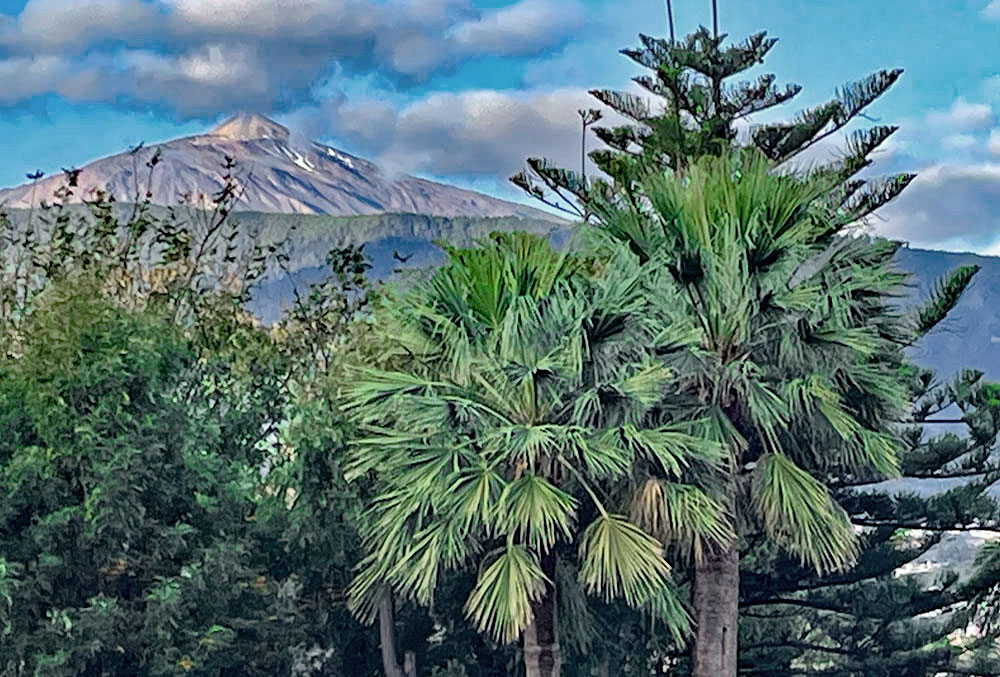
View of Tenerife volcano, Mt. Teide, from Hotel Botanico, ©Ferne Arfin
Under the Volcano on Tenerife
This is a confession: I was wrong about Tenerife.
About ten years ago I first visited Spain’s most popular Canary Island with a large group of fellow travel writers. I had a terrible time – so awful in fact that I vowed never to return. I never wrote about that trip or the various mishaps and disappointments I thought I had endured. Then, recently, the opportunity arose to visit again with the British Guild of Travel Writers. A lot of time had passed since that first trip and (whether I had changed or the island had, I reasoned) maybe it was time to give Tenerife another chance.
Well, it’s also time for me to eat humble pie because Tenerife, I discovered on second viewing, is actually a terrific holiday and vacation destination. It has something to suit just about anyone. The secret to having a splendid time on this dramatic volcanic island is to do your homework before you go and pick the activities and attractions that suit you, that deliver what you really want to do on your vacation, that match your level of daring and fitness or your taste for indulgent, luxurious relaxation. It’s all there. There’s plenty to choose from and now I want to go back to try some of the things I missed.
Tenerife for adventurers
Check out this aerial view of Tenerife and you can see that the whole island seems to flow from a volcano at its centre. Actually, three volcanoes active millions of years ago came together to form Tenerife. Today Mt. Teide, surrounded by the largest of the national parks in the Canary Islands, sits in the caldera of one of the super volcanos that created this place. At 3,715 metres (12,200 feet), the volcano makes Tenerife the tallest island in the Atlantic. Though its last eruption was in 1909, Teide is still active and minor earthquake “swarms” rumble from deep within
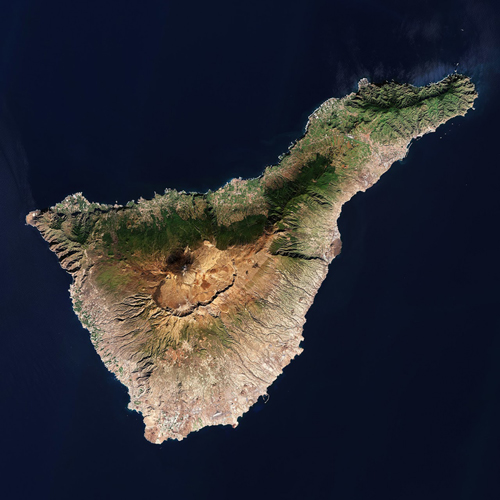
Teide, a quiet but still active volcano sits virtually in the centre of the holiday island of Tenerife, surrounded by challenging terrain. photo courtesy of Turismo Tenerife
the earth occasionally.
This isn’t the place for a geology lesson (and I’m not equipped to deliver it anyway); it’s just worth knowing that Tenerife’s volcanic origins have left it crisscrossed with enough steep slopes and deep ravines to add an adventurous edge to cycle rides and hikes. If you like to challenge yourself but don’t have the time, budget or daring to head for the Everest base camp or to heli-ski in the Pyrenees, you can choose quite a good range of strenuous, satisfying experiences, usually accompanied by spectacular views.
These are some of the most popular:
- Cycle Tenerife – Cycle culture is well developed. You can find all sorts of experiences, from week-long organized tours for the superfit to day cycle hire along paved roads at sea level for beginners. It’s the mountain roads – rising to more than 6,000 feet – that draw some of the world’s greatest professional cyclists – Bradley Wiggens and Chris Froome trained for their Tour de France climbs of Mt Ventoux here. If it all sounds like too much hard work – even if the views will be spectacular – electric bike hire is easy to arrange. Check out Bike Point Tenerife and Tenerife Bike Training
- Hike Tenerife – Descend into a volcanic tube formed 27,000 years ago (Cueva del Viento or cave of the winds), or climb (with a guide and a government-issued permit) to the crater’s edge of Tiede ( you can also
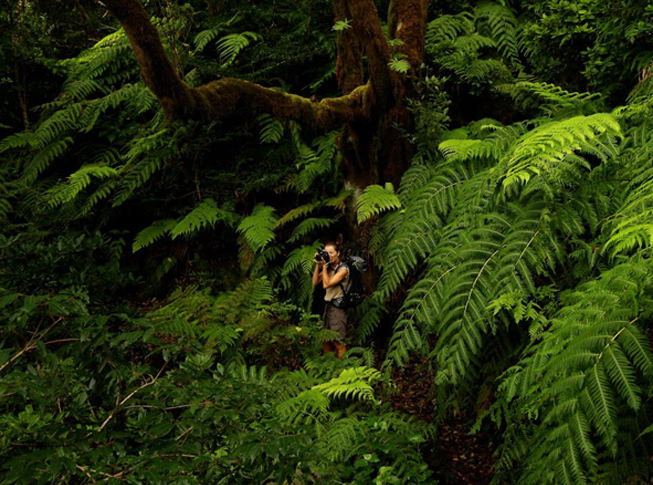
Photo courtesy of Turismo Tenerife
take the slightly easier way by cable car to within about 160 meters of the top). In between, are mountain walks, clifftop and beach hikes, forest walks, and wildlife or birdwatching excursions into the island’s Biosphere Reserve. In my experience, locals sometimes underestimate the level of difficulty for inexperienced walkers or visitors with mobility issues. And it seems to be difficult to find topographical profiles for some of the walking routes. But there is no denying you’ll see the best views and get closest to nature by exploring Tenerife on foot. Recommended suppliers include Anaga Experience, the Cueva del Viento visitor centre, and Gaiatours.
- Watersports in Tenerife- Experienced surfers head for the beaches of the north or northwest, while gentler conditions for surfing and body boarding can be found near the sandy beaches of the south. Playa de Martiánez on the northeast is a black sand beach wrapped around a relatively protected bay with several surf schools. Or try windsurfing or kite surfing at the Surf Centre Playa Sur . Tenerife is also popular with divers who can explore several wrecks around the island or photograph colourful Atlantic and North African marine life. Lessons for beginners are offered by Ocean Friends, who provide a 50-minute “baptism” dive. Or book Diving for Beginners by boat from Puerto Colon on the Costa Adeje from Viator.
- Take to the air over Tenerife – Paraglide through the clouds over Tenerife. Among several paraglide sites offered by Paragliding Tenerife, one of the most thrilling must be the Tiede jump from the slopes of the volcano at 2,2oo feet. through the clouds to the beach below.
Tenerife for nature lovers
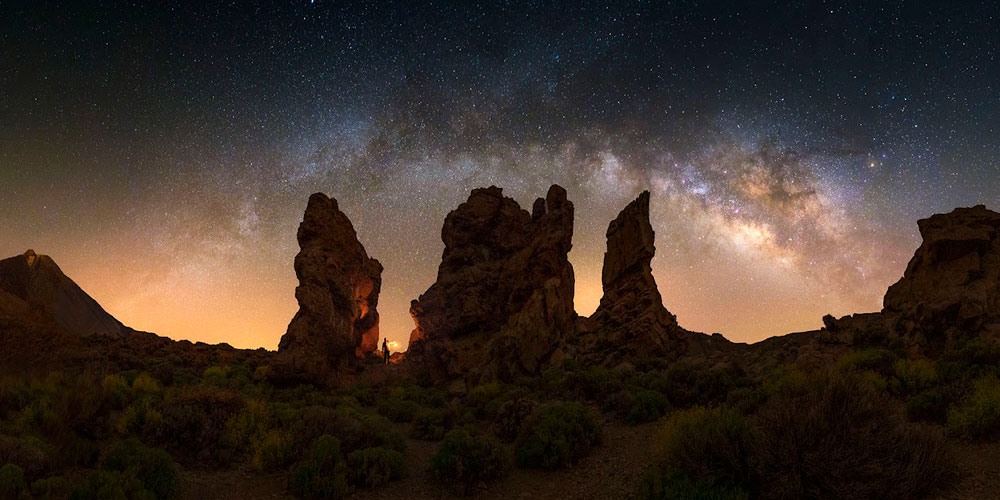
The Milky Way is a vivid presence from more than 2,200 feet on the slopes of Mt. Teide. Photo courtesy of Turismo Tenerife
It’s 10 o’clock at night and I’m 2,200 metres (6,500 feet) above sea level on the slopes of Tenerife’s volcano, Mt. Teide, in pitch darkness. Even though April has nearly ended, the cold at this altitude is brutal and my teeth are chattering. The only light comes from our guide’s high-powered laser as he points to the North Star and picks out the constellations scattered across the velvet sky. Next time when I’m warned to dress warmly for an activity here, I will make a mental note to drop my temperature expectations by about 30 degrees Fahrenheit. Elsewhere, Tenerife has a temperate year-round climate capable of supporting tropical and subtropical species year round. One thing you discover quickly is that here enjoying the natural world comes in many varieties. If nature watching is your jam, bring binoculars, a long-lens camera and your sea legs.
- Stargazing Not all nature is earthbound. When you stargaze from high on the slopes of Teide, under the darkest skies on the island but above the clouds, you’re looking back in time at some of the oldest natural phenomena ever. Stargazing experiences, led by experts, including astronomers, use high-powered lasers and telescopes to guide visitors across the universe. (At last, I know where the North Star is and why it’s so special!). If you decide to do this, plan to pack a very warm winter jacket, gloves and a hat. High in Mt. Teide National Park, at night with no cloud cover, it’s bloody cold.
Book your stargazing experience with Viator here.
- Wildlife watchers can search for at least 70 bird species that breed here. There are plenty of viewpoints and places to spot them – cliff tops,
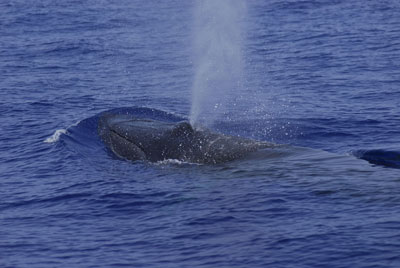
Rare blue whale spotted off Tenerife. photo courtesy of Turismo Tenerife
laurel forests, gardens all over this largest of the Canary Islands – speaking of which, don’t leave without spotting a few canaries, native and symbol of the archipelago. Discover what birds to look for, where to find them and the knowledgeable guides and ecotour organisers who can help you here. Or spot dramatic seabirds snatching their meals from the sea (or mid-air from each other) while whale watching from the pitching deck of a catamaran or excursion boat. Pilot whales and dolphins are regulars and 21 different species of cetaceans have been spotted in these waters. Some are very rare visitors though, if you are lucky, you might spot a Blue whale or a giant Sperm whale passing through in the spring. Book a whale and dolphin watching catamaran cruise with lunch and drinks from Viator.
- Flora You don’t have to go far to enjoy everything from desert plants to tropical and subtropical plants and trees. But you can guarantee a great collection of instagrammable flora by spending a day in one of Tenerife’s gorgeous and historic gardens. The 18th-century Botanical Garden in Puerto de la Cruz was created by royal decree in 1788 to study plants from Spain’s far flung empire closer to home. The five acres of exotic plants include a 200-year-old fig tree. Not far from the Botanical Garden, the Jardin de Orquideas Sitio Litre is a 235-year-old orchid garden cultivated by two English families. Agatha Christie was a fan. And the nearly 30-acre Palmetum in Santa Cruz de Tenerife has 2,000 tropical plants including 500 species of palm collected from just about everywhere and arranged in their geographic settings – from the Caribbean to Australia. Check out their excellent, online 3D tour.
Tenerife for gastronomy
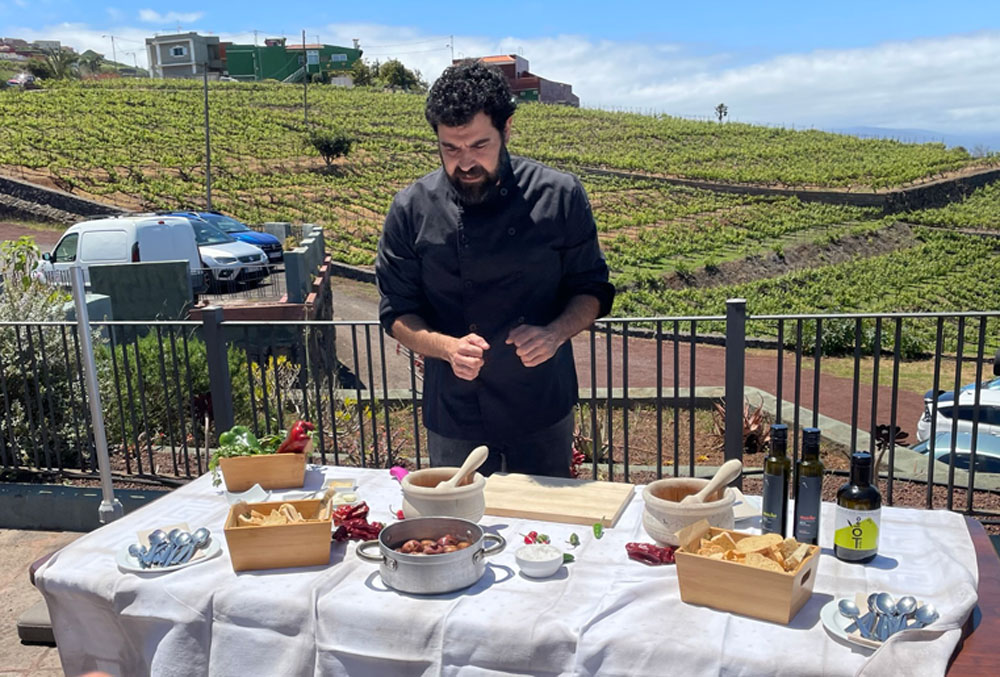
Chef Gaspard Alvarez demonstrates making the famous Canarian specialties, papas arrugadas and green and red mojos. photo by Ferne Arfin
What a setting for a cookery class! The terrace of Bodegas Monje is ablaze with afternoon sunshine and cooled by sea breezes. Below us, the vineyards that
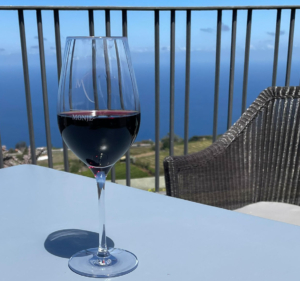
A glass of Tintomonje overlooking the vineyards and the sea. ©Ferne Arfin 2022
support the Bodegas’ winemaking slope away to the brilliant blue Atlantic. We’re learning to make three classic Tenerife specialities, two condiments known as mojos (mojo rojo made with garlic red peppers and chili, mojo verde made with either parsley or cilantro) and papas arrugadas, wrinkly little potatoes
cooked in salt water, served as a snack or alongside meats. (Check recipes and methods here). Since 1750, five generations of the Monje family have made wine here. Today you can stop by for breakfast or lunch of rustic local dishes (the firewood roasted pork is incredibly more-ish, as is the salad with thinly sliced, wilted Spanish onions. Then tour the winery, sample the wines or take a cookery workshop and shop for wine and locally made products. You can book this winery experience with Viator before you leave home.
With five Michelin-starred restaurants on Tenerife and dozens of local cafés and restaurants, dining choices to suit any taste – from the simple to the sophisticated – are not in short supply. But do be sure to sample the native cuisine that combines Spanish, North African and South American influences.
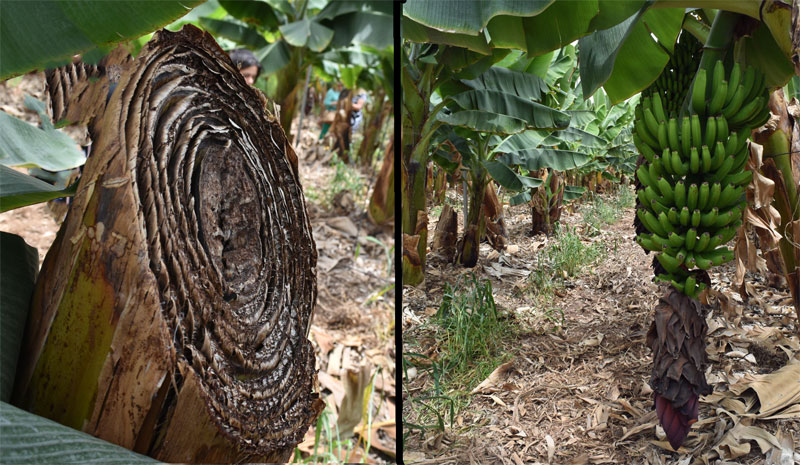
For an unusual gastronomic experience, visit Finca La Calabacera Ecologia, an organic farm and banana plantation, high over the coast. Guided tours can be booked where you learn more about bananas than you ever thought possible. Did you know, for example, that banana trees are not trees at all – the tree “trunks” – above left- are layers of dead leaves accumulated as the plant grows upward. Besides bananas, the finca grows all sorts of exotic fruits and vegetables. We sampled Zapote Negra, a variety of persimmon sometimes called chocolate pudding fruit because of the colour and flavour of its soft, spoonable. flesh. Tours can be arranged by emailing [email protected] or phoning +34 647 83 69 94
.
Tenerife for relaxation
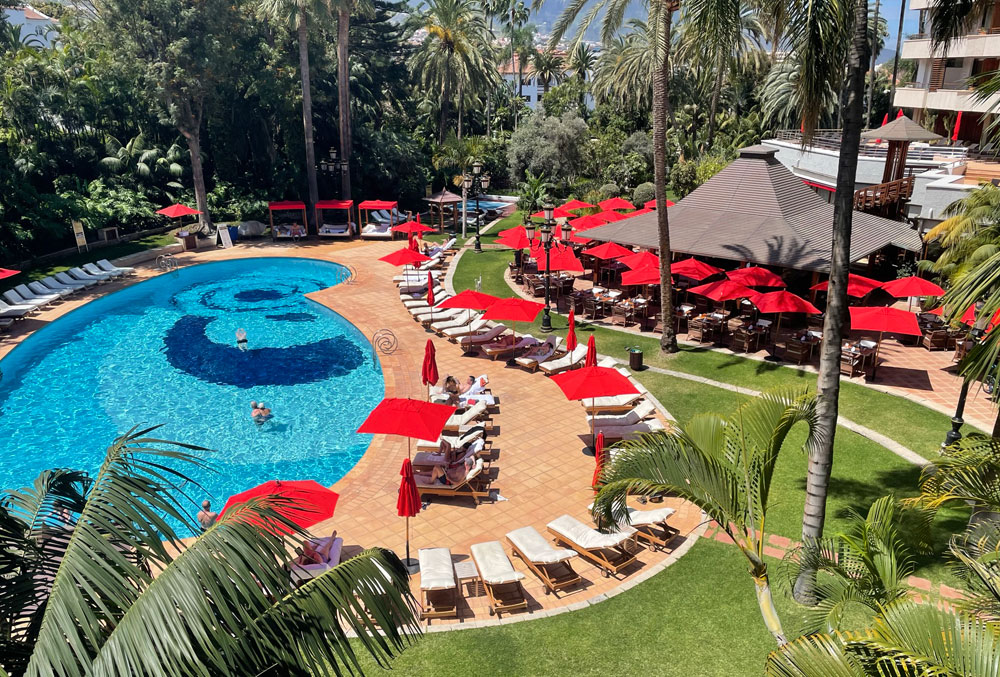
Pool at the Hotel Botanico in Puerto de la Cruz on the north of the island. Long enough and deep enough for a good swim but with a generous shallow end for non-swimmers as well. There’s also a children’s pool. In April, when we visited, the pool was heated to a comfortable 31 degrees C (88 F). With a cooling sea breeze, it was just right. ©Ferne Arfin
If your idea of a great holiday is a luxury break where you lounge around and do nothing much, then you’ve come to the right place. The island is very well organised for that kind of vacation. Many if its luxury hotels, which are often priced more moderately than similar accommodation at comparable resorts, feature:
- generous outdoor pools – often heated for year-round swimming
- fully equipped spas with gyms, treatments, health and wellness programmes and indoor pools.
- multiple restaurants so guests staying on a full or half board basis don’t have to go far for a variety of dining options
Spas Hotel spas are almost always available – with advance booking – to non-guests. Beauty treatments, health and wellness regimes, massages and aqua or hydro spa facilities are concentrated in hotels along the Costa Adeje in the Southwest and near Puerto de la Cruz in the north. At The Sheraton La Caleta Resort and Spa in Adeje, we sampled a thalasso therapy pool, steam room and sauna. Generous robes and towels were included and the experience was peaceful and uncrowded. Two small “Roman” baths were located in an outdoor area separated by a wall and dense foliage from the hotel’s main pools. On a cool and breezy day, the hot Roman bath was perfect. I wasn’t brave enough to try the chilled bath and (on that particular day) it didn’t appear that anyone else was either. Click for spas for more information about natural treatments, alternative and beauty therapies, spas and medical centres.
Golf I confess, I don’t play golf so I can’t speak with expertise, but the golf courses I’ve seen on Tenerife look positively gorgeous. Some are dotted with lakes and palm trees, some overlook the sea and the nearby island of La Gomera, some are overlooked by the volcano, El Teide. Several have been designed by leading course designers, one by leading Spanish golfer Severiano Ballesteros. There are nine courses available to the public – either on a daily greens fee basis or as part of multi-day packages that must be booked with accommodation. Turismo Tenerife provides golf information including links to the courses and to companies that can arrange golfing holidays.
Yoga I’d never done yoga before and I was worried that I wouldn’t be flexible enough to try it. But something just irresistible about spreading a mat on soft grass under a cloudless blue sky made an attempt inevitable. I needn’t have worried. Our class, overlooking the golf course of the very exclusive Abama Resort, geared to the individual abilities of our small group of beginners, was relaxing and refreshing. It was delivered by Tenerife native Raquel Gonzales and ended with some mindfulness training that involved touching, smelling and eating a skewer of various fruits with our eyes closed. Did you know that the primary sensation of eating watermelon isn’t the taste or even the sweetness? It’s the sound it makes. Try eating it with your eyes closed and you’ll see what I mean. Raquel’s classes don’t come cheap but don’t worry. Turismo Tenerife’s directory lists wellness spas and hotels with wellness centres all over the island where you can try individual and group classes or all-inclusive yoga retreats to suit most budgets.
Tenerife for very senior visitors I was surprised when a friend pointed out that his frail, elderly relatives, in their late 80s and 90s, enjoyed holidays in Tenerife. With the island’s often challenging terrain and long steep hills, it seemed counterintuitive to me. But, in fact, the island is perfect for visitors who don’t really want to be active at all. Think of the kind of vacationer who enjoys luxury cruising but may be worried about long ocean voyages, about seasickness and, given recent history, about being stuck at sea in an enclosed environment, with hundreds of other travellers, when a pandemic rages. Or maybe they just can’t afford a luxury cruise. Staying at one of Tenerife’s four or five-star hotels is a bit like being on a luxury cruise but cheaper. A choice of restaurants (sometimes included in an all-inclusive price) indoor and outdoor pools, spa treatments and sometimes entertainment and special events, are all concentrated within easy reach or relatively close to each other. Some hotels have free shuttle services to town centres or attractions, some even organize excursions. Taxis, for more independent travellers are relatively cheap and easy to arrange.
Tenerife for families

Tenerife’s Siam Park was voted the world’s top water park in 2022 by Tripadvisor users. photo by Ferne Arfin
This is an easy family vacation and holiday destination. Many hotels are geared to family visitors with suites and adjoining rooms, kids clubs, kids pools and child-friendly menus. On outings, it’s easy to find child-friendly menus and the usual burgers and pizzas for the fussiest young children. It’s also a great place to introduce children with a more adventurous palate to something new. The local Tenerife cuisine, and Spanish cooking in general, is mild – it gets its fire and spice from condiments young diners can choose to add to their food or not.
Beaches on the island vary but there are several sandy beaches in sheltered bays where children can safely splash. And among the child-pleasing local attractions is Siam Park, a Thai-themed waterpark that tops Tripadvisor international polls year after year.
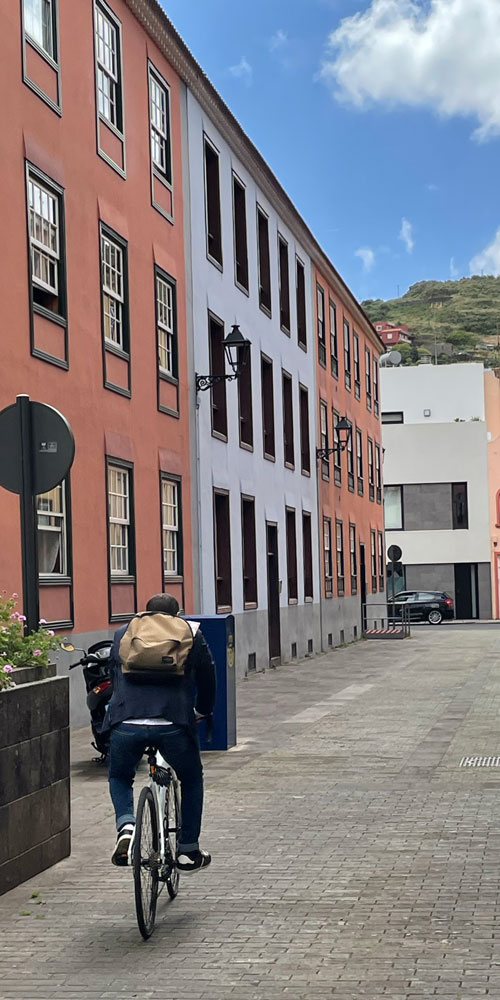
A colourful street of flat-fronted houses in San Cristobal de La Laguna, Tenerife’s historic UNESCO World Heritage Site. Photo by Ferne Arfin 2022
Tenerife for sightseeing and shopping
If no holiday is complete for you without some sightseeing and shopping, you won’t be disappointed. Tenerife boasts two designated UNESCO World Heritage sites: Teide National Park, surrounding the volcano, and San Cristobal de la Laguna, the 500-year-old former administrative centre of the Canary Islands. Many of the churches, private and administrative buildings, wide streets and public squares date from the 16th to the 18th centuries. A total of 627 of its 1,470 buildings are classified and preserved.
According to the UNESCO World Heritage list:
“San Cristóbal de La Laguna is the first example of an unfortified town with a grid model that was the direct precursor of the settlements in the Americas under Spanish rule during colonial times.”
UNESCO describes the town as a model for “many colonial towns in the Americas.”
To get the most out of a visit to La Laguna, hire a guide – better yet, read a book before you go. And if you are a real history and architecture buff, make sure your guide knows that. We had an amusing time with a lively local guide but we didn’t have time to go inside any of the churches, museums or the few buildings open to the public and didn’t really learn very much.
More historic places and monuments
La Laguna may be one of the more important historic towns on Tenerife, but as a bridge to the colonial explorations of Spain and Portugal, the island is not short of interesting colonial-period towns and villages to explore. Turismo Tenerife has a rundown of historical places to visit on its website.
And don’t forget the shopping
Shopping in the main towns , as far as I was able to experience, seemed to consist primarily of modern European goods. But duck into the side streets of Puerto de la Cruz and Santa Cruz de Tenerife and you may find surprises. Santa Cruz is also home to several large, modern shopping malls and a few of Spain’s leading luxury department stores. Puerto de la Cruz is also home to the recently refurbished Mercado Municipal, an indoor and outdoor public market where food, clothing and household goods are sold in a typically European market environment. It’s worth looking for the local cheeses – often vacuum sealed so that you can travel with them, Tenerife honey and the characteristic sauces known as mojos (by the way, come back soon for recipes for mojos from my Bodega Monje cooking lesson).
The Tenerife Nitty Gritty
Tenerife is a hugely popular holiday destination for the British, mainland Spanish and Germans. So every type of accommodation for every budget is available – hotels in all price ranges, guest houses, villas, apartments, quite cheap hostels and an incredibly located, government-run historic inn or parador in the caldera of Teide at more than 2,000 meters above sea level.
As guests of Turismo Tenerife and its member businesses, we stayed in two luxury hotels:
- 5-star Sheraton La Caleta Resort and Spa – Located on the Costa Adeje in the southwest, this hotel has 284 rooms with private balconies and
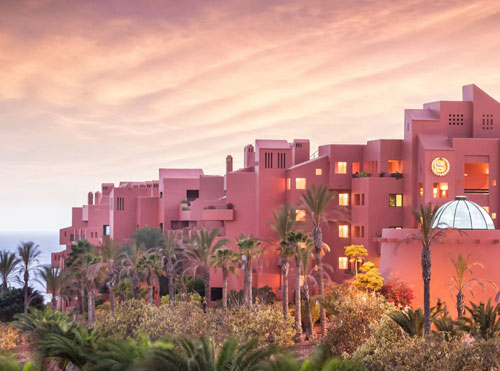
5-Star Sheraton La Caleta Resort & Spa,Costa Adeje, Tenerife
terraces, marble baths, free wi-fi and the kind of service you demand of a 5-star. Bathrooms have separate showers and baths and are supplied with robes generous enough to snuggle into ( for cocktails on your terrace perhaps after a power shower). Balconies on the higher floors have sea views while those on the lower floors overlook the gardens and pool. Mine, a corner room on the first floor, had a huge polygonal outdoor space that was more a terrace than a balcony. It faced the pool apparently – though a jungle of foliage meant I couldn’t actually see it. What I did sense, however, was the splashing sounds of a poolside fountain. Very soothing, but if that’s not for you, you could request a higher floor when booking. The hotel has a spa where you can book treatments or just enjoy steam, sauna and a big hydrotherapy pool as well as two small, outdoor Roman spa pools where you can swim (one or two strokes at most) against a current in chilled or hot water. The hotel is located near a small parade of shops and is less than two kilometres from the luxury shopping of Plaza del Duque. On the downside, the hotel has a definite international business hotel vibe. Public areas are bright and spacious but, somehow, a little bit soulless. you could be anywhere. That goes for where you are in the hotel as well. The sameness of the hotel corridors is disorienting. Get off the lift and there are few clues as to where you are. I kept running into colleagues looking for their rooms on the wrong floor. It’s also located in the virtual concrete jungle of the Costa Adeje so some distance from the best hiking, cycling and swimmable beaches. Click here to book the Sheraton Caleta Resort and Spa now and get a great rate.
- 5-star Hotel Botánico & Oriental Spa Garden – This hotel, in Puerto de la Cruz has one of the best hotel pools I’ve ever had the pleasure of
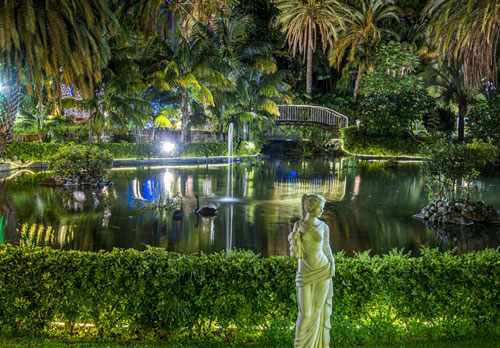
Gardens wrap around one of the pools of The Hotel Botanico in Puerto de la Cruz
using. On the day I took the plunge, the temperature of the main outdoor pool was 31 C (about 89 F) – very comfortable given that the ambient outdoor temperature on the day was barely 21C (70F). The hotel’s Oriental Spa has several other indoor and outdoor pools and hotel guests have free access to the Spa’s thermal circuit. This hotel is located within one of Tenerife’s biggest towns, with easy access to the shopping, bars, restaurants, cafes and general buzz of its setting in an urban centre. Among the nearby attractions, the 18th-century Botanical Garden is just across the street. But without leaving the hotel, you’d never even notice because it’s wrapped in 25,000 m2 (more than six acres) of landscaped tropical gardens – more than enough space to lose yourself in a pre-dinner or after-swim stroll. The hotel has 252 rooms, including 52 suites. Higher rooms have garden, sea or Teide (volcano) views. My room, with its smallish balcony, had a volcano view (the main picture for this post, in fact). They are furnished in a classic style – dark woods, patterned bed coverings. Corridors are wood panelled and public areas are decorated with carefully selected artwork – paintings, Thai sculpture (the owner also owns Siam Park) and an enormous glass mobile (a flock of glass birds in flight) that lights the main lobby. On your way to the lifts, you can stop to admire what at first looks like a colourful video installation but is, in fact, a giant aquarium filled with swimming jellyfish. On the downside, if you want to wander down to the older part of Puerto de la Cruz to see its harbour, black sand beach, churches, shops and entertainment area, you’d better wear your hiking boots. The hotel is in the town’s upper town and the way to the commercial and historic centre is short but extremely steep. The good news is buses are available and taxis are cheap and easy to pick up around Plaza del Charco. Check out the best deals for the Hotel Botanico & Oriental Spa Garden on Tripadvisor.
Visit Tripadvisor to find the right room on Tenerife for your budget and your travel style




 Ferne Arfin
Ferne Arfin
Trackbacks & Pingbacks
[…] – potatoes, maize and beans, for example – and the realities of agriculture on a volcanic island shape the cuisine. So not much beef – for lack of grass grazing land – but lots of […]
Leave a Comment
What do you think?Please add your comments and suggestions here.